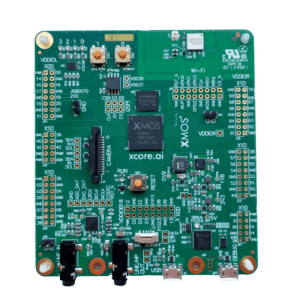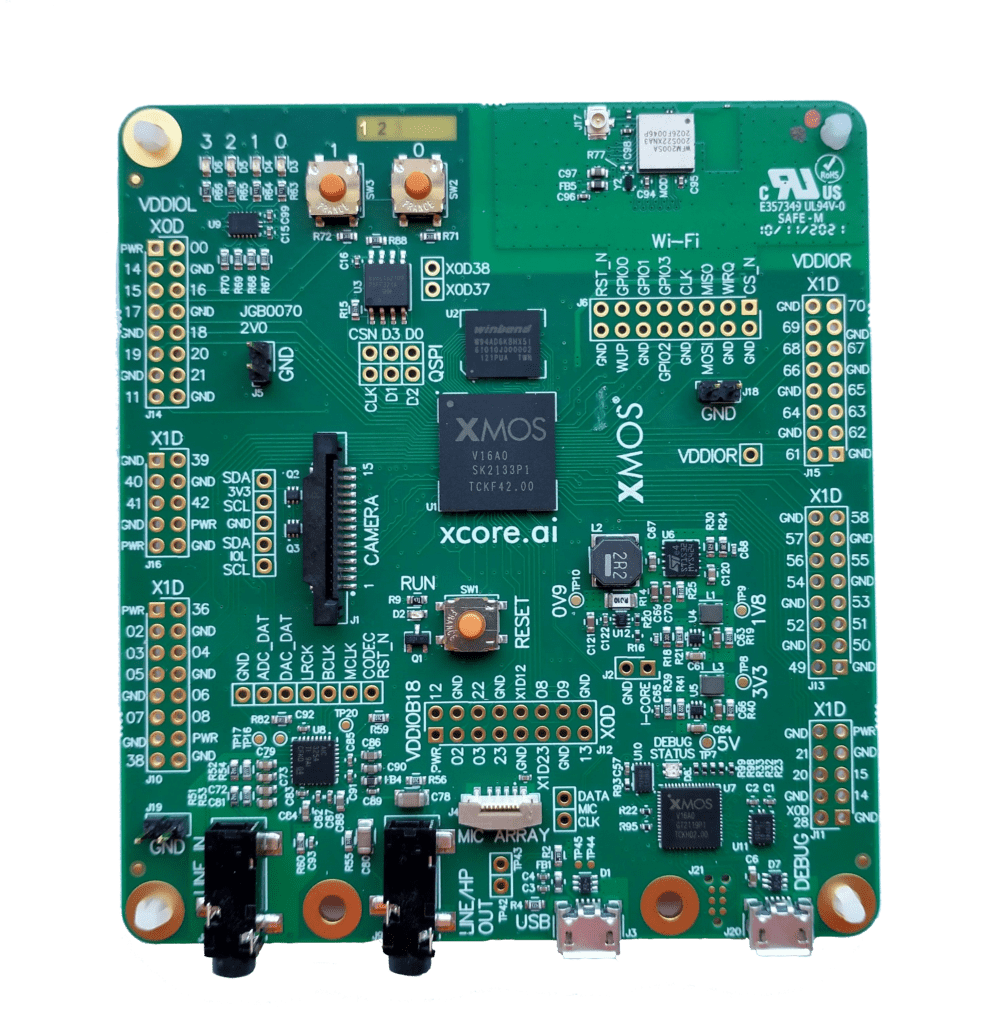A.I.
Effective AI inferencing for embedded systems

MANAGEMENT

ACTIVATED
ASSISTANTS

LIGHTING

SYSTEMS

HVAC

MAINTENANCE
Key features
 Programmable Performance
Programmable Performance
- 256-bit vector processing unit with 100GOPS int-8 AI inferencing performance.
- No heterogeneous communication overhead.
- Supports binarized networks, achieving over 800GOPS.
- 1MB on-chip SRAM supporting AI models with up to ~800kB tensor arena requirement.
- Weights stored in external flash memory. Large on chip memory maximizes AI model inference performance.
 Easy to use
Easy to use
- XMOS AI Tools allow deployment of AI Models developed in Python-based environments like PyTorch and Tensorflow.
- Models are optimized for embedded use with Tensorflow Lite with high performance operators that exploit the xcore.ai capabilities and minimize tensor arena sizes.
- Generated C code can be integrated with other embedded functions allowing xcore.ai to efficiently handle image-based and audio-based applications.
- While most embedded AI apps use 8-bit quantization, xcore.ai also supports binarized networks and larger datatypes (e.g., floating point) where needed.
 Flexible & Scalable
Flexible & Scalable
- Unique design with 16 independent hardware threads per device
- Threads can be used independently or collaboratively.
- Supports a diverse range of functions, including; AI inferencing, signal conditioning, I/O and control
- High-speed communication between threads and between devices provides:
- Scalability of performance and memory.
- Concurrent implementation of high-performance inferencing alongside other functions
Technical
| Part Number | Package | IO voltage | IO | External Interfaces | Datasheet | Buy |
|---|---|---|---|---|---|---|
| XU316-1024-QF60A | 60pin QFN (7x7mm) | 1v8 | 34 | USB | DATASHEET | |
| XU316-1024-QF60B | 60pin QFN (7x7mm) | 3v3 | 34 | USB | DATASHEET | |
| XU316-1024-FB265 | 265pin FBGA (14x14mm) | 1V8 / 3V3 | 128 | USB, Single or Dual lane MIPI D-PHY receiver, LPDDR1 | DATASHEET | |
| XU316-1024-TQ128 | 128pin TQFP (14x14mm) | 1V8 / 3V3 | 78 | USB, Single or Dual lane MIPI D-PHY receiver | DATASHEET |
Start your development with the


XCORE.AI
EVALUATION KIT
The xcore.ai evaluation kit allows testing in multiple application scenarios and provides a good general software development board for simple tests and demos.
Our kit includes
- the xcore.ai crossover processor
- 4 general purpose LEDs
- 2 general purpose push-button switches
- a PDM microphone connector
- audio codec with line-in and line-out jack
- QSPI flash memory
- LPDDR1 external memory
- 58 GPIO connections from tile 0 and 1
- micro USB for power and host connection
- MIPI connector for a MIPI camera
- xSYS2 connector for debug adapter
- a reset switch with LED to indicate running.
Developer Resources
| Title | Version | Date | Download |
|---|---|---|---|
| The XMOS XS3 Architecture | 2025-03-06 | html | |
| Tools 15 - Documentation | 15.3.1 | 2025-10-01 | tgz |
| XU316-1024 xcore.ai Datasheet | 2.0.0 | 2025-01-13 | html |
| XU316-1024-FB265 Datasheet | 2.0.0 | 2025-01-13 | html |
| XU316-1024-QF60A Datasheet | 2.0.0 | 2025-01-13 | html |
| XU316-1024-QF60B Datasheet | 2.0.0 | 2025-01-13 | html |
| XU316-1024-TQ128 Datasheet | 2.0.0 | 2025-01-13 | html |
| xcore.ai FB265 package port map | 1.0 | 2025-03-11 | xls |
| xcore.ai I/O Timings | 2024-10-21 | html | |
| xcore.ai Package port map | 2024-04-03 | xls | |
| xcore.ai Product brief | 7.0 | 2025-06-26 | |
| xcore.ai QF60A/B package port map | 1.0 | 2025-03-11 | xls |
| xcore.ai TQ128 package port map | 1.0 | 2025-03-11 | xls |
| Title | Version | Date | Download |
|---|---|---|---|
| XU316-1024-FB265 BSDL File | 1.0 | 2025-02-04 | bsd |
| XU316-1024-QF60 BSDL File | 1.0 | 2025-02-04 | bsd |
| XU316-1024-TQ128 BSDL File | 2025-02-10 | bsd | |
| xcore.ai Evaluation Kit Altium and Manufacturing files | 2.0 | 2022-07-19 | zip |
| xcore.ai Evaluation Kit Schematics | 2.0 | 2022-07-26 | |
| xcore.ai Evaluation Kit v2.0 hardware manual | 2V0 | 2024-02-12 |

 Programmable Performance
Programmable Performance